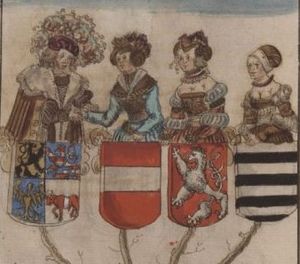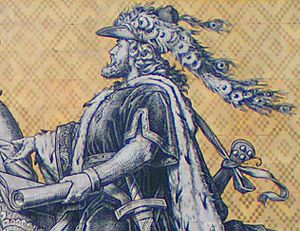Henry III, Margrave of Meissen facts for kids
Quick facts for kids Henry III |
|
|---|---|

Margrave Henry of Meissen, Codex Manesse
|
|
| Margrave of Meissen | |
| Reign | 1221–1288 |
| Predecessor | Theodoric I |
| Successor | Albert II |
| Regent | Louis IV of Thuringia (until 1217) Albert I of Saxony (until 1230) |
| Margrave of Lusatia | |
| Reign | 1221–1288 |
| Predecessor | Theodoric II |
| Regent | Louis IV of Thuringia (until 1217) Albert I of Saxony (until 1230) |
| Landgrave of Thuringia, Count Palatine of Saxony |
|
| Reign | 1242–1265 |
| Predecessor | Henry Raspe |
| Successor | Albert II |
| Born | 1215 Meissen, Duchy of Saxony, Holy Roman Empire |
| Died | 15 February 1288 (aged 72–73) Dresden, Duchy of Saxony, Holy Roman Empire |
| Spouse | Constance of Babenberg Agnes of Bohemia Elisabeth von Maltitz |
| Issue | Albert II, Margrave of Meissen Theodoric of Landsberg |
| House | House of Wettin |
| Father | Theodoric I, Margrave of Meissen |
| Mother | Jutta of Thuringia |
Henry III, also known as Henry the Illustrious, was an important ruler from the House of Wettin. He was born around 1215 and died on February 15, 1288. From 1221 until his death, he was the Margrave of Meissen and the last Margrave of Lusatia. Starting in 1242, he also became the Landgrave of Thuringia.
Contents
Life and Rule of Henry III
Early Life and Becoming a Ruler
Henry was likely born at the Albrechtsburg castle in Meissen. He was the youngest son of Margrave Theodoric I, Margrave of Meissen and his wife Jutta. Jutta was the daughter of Landgrave Hermann I of Thuringia.
In 1221, when his father died, Henry became the Margrave of Meissen and Lusatia. Because he was still young, his maternal uncle, Landgrave Louis IV of Thuringia, looked after him. After Louis IV died in 1227, Duke Albert I of Saxony became Henry's guardian. By 1230, Henry was officially old enough to rule on his own.
Military Actions and Land Changes
Around 1234, Henry gained his first experience in battle. He went on a crusade to Prussia and fought against the Pomesanians. His journey was well-documented, and it led to the building of Balga castle. This castle became a key center for the Teutonic Knights.
In 1245, after many years of fighting with the Ascanian margraves of Brandenburg, Henry had to give up some fortresses. These included Köpenick, Teltow, and Mittenwalde, which were north of Lower Lusatia. However, in 1249, the Silesian duke Bolesław II the Bald gave him land near Schiedlo Castle by the Oder river. Here, Henry founded the town of Fürstenberg.
Political Alliances and Thuringian Succession
Henry supported Emperor Frederick II of the Hohenstaufen family. This was during a conflict between the Emperor and Pope Gregory IX. In return for his loyalty, Frederick II promised Henry that he would inherit the lands of Henry Raspe. This included the title of Landgrave of Thuringia and Count palatine of Saxony. In 1243, the Emperor also arranged for his daughter Margaret of Sicily to marry Henry's son, Albert II.
Henry remained a strong supporter of the Hohenstaufens. Only after Frederick's son Conrad IV left Germany did Henry accept William of Holland as the new king. After Henry Raspe died in 1247, Henry III fought to claim Thuringia. This conflict was known as the War of the Thuringian Succession. He fought against Sophie of Thuringia, who was the daughter of the late Landgrave Louis IV, and her husband Duke Henry II of Brabant. He also fought against Prince Siegfried I of Anhalt-Zerbst.
After a long war, Henry separated the Landgraviate of Hesse in the west. He gave it to Sophie's younger son, Henry. However, Henry III kept Thuringia for himself. He then gave Thuringia and the Palatinate of Saxony to his own son, Albert II. This acquisition of Thuringia greatly increased the lands controlled by the Wettin family. Their territory now stretched from the Silesian border in the east to the Werra river in the west. It also went from the border with Bohemia in the south to the Harz mountains in the north.
From 1273, Henry was a key supporter of the newly chosen King Rudolph of Habsburg. Rudolph was fighting against his rival, King Ottokar II of Bohemia. Henry helped Rudolph win control of places like Sayda and Purschenstein Castle.
Patron of Arts and Culture
Henry was known across the empire as a brilliant prince. He was famous for supporting the arts and was seen as a model knight. He was also a significant minnesinger, which means he was a poet and composer. Henry sponsored many tournaments and singing competitions, and he even took part in them himself. He also ordered the creation of the famous Christherre-Chronik. He even set hymns to music for churches, with special permission from the Pope.

Family Life and Legacy
Marriages and Children
In 1234, Henry married Constance of Babenberg. She was the daughter of Duke Leopold VI of Austria. Henry and Constance had two sons:
- Albert II, Margrave of Meissen (born 1240, died 1314)
- Theodoric of Landsberg (born 1242, died 1285)
After Constance died in 1243, Henry married Agnes. She was a daughter of King Wenceslaus I of Bohemia. Agnes died in 1268. For his third marriage, Henry married Elisabeth von Maltitz. She was the daughter of a ministerialis, a type of serving knight. Elisabeth had two sons with Henry: Friedrich Clem and Hermann the Long.
Division of Lands
As early as 1265, Henry added the Imperial Pleissnerland (around Altenburg) to the Landgraviate of Thuringia. This land was part of his daughter-in-law Margaret's dowry. He then gave both Thuringia and Pleissnerland to his older son, Albert II. For his younger son, Theodoric, Henry created the smaller Margraviate of Landsberg. This was in the western part of Lusatia, near Leipzig, though he did this without the Emperor's official approval.
Henry kept only the Margraviate of Meissen and the remaining lands of Lower Lusatia for himself. He also kept a formal power to oversee his sons' territories. However, problems within his family, caused by his son Albert, made Henry's later years difficult. These issues continued long after his death in 1288. They eventually led to the loss of Lusatia and Thuringia for the Wettin family.
See also
 In Spanish: Enrique III de Meissen para niños
In Spanish: Enrique III de Meissen para niños


